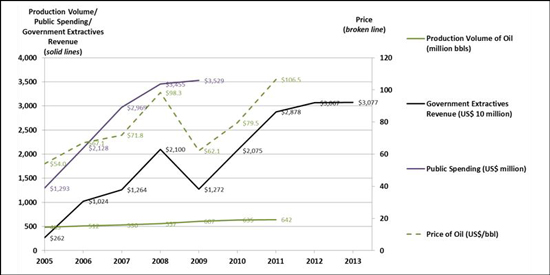
Seize the Dataset: Newly Collected EITI Numbers, and Some Ideas About Better Reporting
In the past six months, 24 countries have released new Extractive Industries Transparency Initiative (EITI) reports disclosing over $200 billion in payments from more than 2,000 companies. These are the first reports prepared under the broader EITI Standard that was introduced in 2013, and they include information not just on revenue payments, but also on licensing, exploration, production, state-owned enterprises, subnational transfers and budget processes. These new reports are the latest of a total of 240 EITI reports (more than a decade's worth) covering $1.6 trillion in extractives-related revenues. While these figures are striking, they also raise the question: What do we do with this data deluge? The answer is that we must learn from it.
What's new?
NRGI analysts have reviewed this first wave of new EITI reports, finding them considerably more comprehensive and informative. However, it was also evident that several areas require significant improvement if EITI implementation is to lead to actual reform. NRGI has compiled the findings from this review into a briefing on the quality and content of these new EITI reports, offering recommendations and concrete examples on both areas of achievement and areas for improvement. We hope that country-level EITI groups will consider these recommendations as they supplement existing reporting, develop new reports, and develop action plans for how to translate EITI reporting into real-world reforms.
One of the key findings outlined in our briefing is the need for more open data, given that the wealth of information in almost all EITI reports remains locked in PDFs that limit meaningful analysis. To address this issue, NRGI has collected into a new dataset information from 223 EITI reports published by 37 countries before February 2015. We went back to each EITI report and gathered commodity-specific information on production and revenue at the country and project levels. We complemented EITI information with other sources for production volumes and commodity prices, and also included macroeconomic and social indicators for each country and year to help put extractive revenues into perspective. Then we created some interactive visualizations to illustrate some of the findings.
With this dataset, users are able to explore different countries and compare categories of data that is of interest to them. We hope various stakeholders will use the data to ask questions like: "How much does my country spend on education and how does that compare with the revenues it collects from oil?" Or "How much of my government's revenues come from extractives? Is my country resource-dependent?" Or "Does my country get more revenues from international aid or from its resources?"
The dataset can also be used for further quantitative analysis of the sector. Visualizations of the data can help identify interesting trends and tell stories that lead interested parties to undertake further analysis.
In April, NRGI organized a Eurasia regional EITI data analysis workshop where we provided the dataset to participants and encouraged them to build Excel graphs and highlight interesting findings. Some participants used EITI reports and the dataset to develop the chart below, which illustrates Kazakhstan's production volume and price of oil over time, along with the government's extractive revenues and public spending. The participants' findings raised interesting questions, such as: What will be the impact of the recent commodity price decline for Kazakhstan?

What's next?
NRGI will monitor progress on many of the recommendations outlined in the briefing as part of the indicators in the next Resource Governance Index. We will also provide platforms for groups that have used both the briefing and the dataset to share experiences and findings, including at the EITI Global Conference in February 2016, in Lima, Peru. In the meantime, feel free to email Marie Lintzer with questions or examples of how you are using these tools at [email protected].
With more and more project-level information published, users might also be interested in looking at data on a specific mine or oil field. NRGI will continue collecting more project-disaggregated information, linking it with resource contracts, local impacts and company reports to conduct analysis.
Erica Westenberg is a senior governance officer at the Natural Resource Governance Institute (NRGI). Marie Lintzer is a governance officer at NRGI.
Authors

Erica Westenberg
Governance Programs Director
